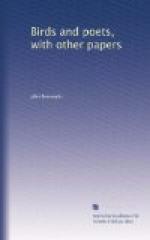Though so young a people, there is not much of the feeling of spring in any of our books. The muse of our poets is wise rather than joyous. There is no excess or extravagance or unruliness in her. There are spring sounds and tokens in Emerson’s “May-Day:”—
“April
cold with dropping rain
Willows
and lilacs brings again,
The
whistle of returning birds,
And
trumpet-lowing of the herds.
The
scarlet maple-keys betray
What
potent blood hath modest May,
What
fiery force the earth renews,
The
wealth of forms, the flush of hues;
What
joy in rosy waves outpoured
Flows
from the heart of Love, the Lord.”
But this is not spring in the blood. Among the works of our young and rising poets, I am not certain but that Mr. Gilder’s “New Day” is entitled to rank as a spring poem in the sense in which I am speaking. It is full of gayety and daring, and full of the reckless abandon of the male bird when he is winning his mate. It is full also of the tantalizing suggestiveness, the half-lights and shades, of April and May.
Of prose poets who have the charm of the springtime upon them, the best recent example I know of is Bjornson, the Norwegian romancist. What especially makes his books spring-like is their freshness and sweet good faith. There is also a reticence and an unwrought suggestiveness about them that is like the promise of buds and early flowers. Of Turgenieff, the Russian, much the same thing might be said. His stories are simple and elementary, and have none of the elaborate hair-splitting and forced hot-house character of the current English or American novel. They spring from stronger, more healthful and manly conditions, and have a force in them that is like a rising, incoming tide.
VI OUR RURAL DIVINITY
I wonder that Wilson Flagg did not include the cow among his “Picturesque Animals,” for that is where she belongs. She has not the classic beauty of the horse, but in picture-making qualities she is far ahead of him. Her shaggy, loose-jointed body; her irregular, sketchy outlines, like those of the landscape,—the hollows and ridges, the slopes and prominences; her tossing horns, her bushy tail, tier swinging gait, her tranquil, ruminating habits,—all tend to make her an object upon which the artist eye loves to dwell. The artists are forever putting her into pictures, too. In rural landscape scenes she is an important feature. Behold her grazing in the pastures and on the hillsides, or along banks of streams, or ruminating under wide-spreading trees, or standing belly-deep in the creek or pond, or lying upon the smooth places in the quiet summer afternoon, the day’s grazing done, and waiting to be summoned home to be milked; and again in the twilight lying upon the level summit of the hill, or where the sward is thickest and softest; or in winter a herd of them filing along toward the spring to drink, or being “foddered” from the stack in the field upon the new snow,—surely the cow is a picturesque animal, and all her goings and comings are pleasant to behold.




